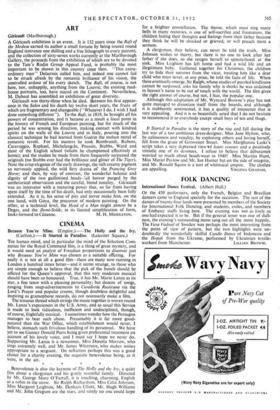ART
Gericault (Marlborough.)
A Gericault exhibition is an event. It is 132 years since the Raft of the Medusa earned its author a small fortune by being toured round England (entrance one shilling and a free lithograph to every patron), and the collection of sixty-seven works currently at the Marlborough Gallery, the proceeds from the exhibition of which are to be devoted to the Tate's Rodin Group Appeal Fund, is probably the most important to be shown in this country since then. "This extra- ordinary man" Delacroix called him, and indeed one cannot fail to be struck afresh by the romantic brilliance of his vision, the controlled ardour of his every sketch. The Raft, of course, is not here, nor, unhappily, anything from the Louvre; the existing, mad- house portraits, too, have stayed on the Continent. Nevertheless, M. Dubaut has assembled an exhibition of great diversity.
Gericault was thirty-three wherkhe died. Between his first appear- ance in the Salon and his death lay twelve short years, the fruits of which are fragmentary and changeable ("Whatever I do, 1 wish I had done something different"). To the Raft, in 1819, he brought all his powers of concentration, and it became as a result a focal point in the history of French and European painting, but for much of the period he was sensing his direction, making contact with kindred spirits on the walls of the Louvre and in- Italy, pouring into the classical technique he had learned from Guerin the molten metal of romantic revolt. For his masters he took Rembrandt, Rubens, Caravaggio, Raphael, Michelangelo, Poussin, Stubbs, Ward and most of the English school (whoin he championed effectively at home); and the studies he made from them frequently surpassed the originals (no Stubbs ever had the brilliance and glitter of The Tiger). Note the crisp elegance of the early drawings, the rich creamy pigment so nervously applied, the wild fiery drama of the Prancing Grey Horse; and then, by way of contrast, the wonderful balance and dignity of the two guillotined heads--L'all horror purged by the unrhetorical observation and the careful, blond tonality. Gericault was an innovator with a maturing power that, so far from having spent itself by the time of his death, had only occasionally been fully extended. As it is, his sense of pity and terror make him, on the one hand, with Goya, the precursor of modern painting. On the other, at a technical level, the Head of a Man might almost be a Degas, and the Demi-Solde, in its faceted simplification of form,


































 Previous page
Previous page